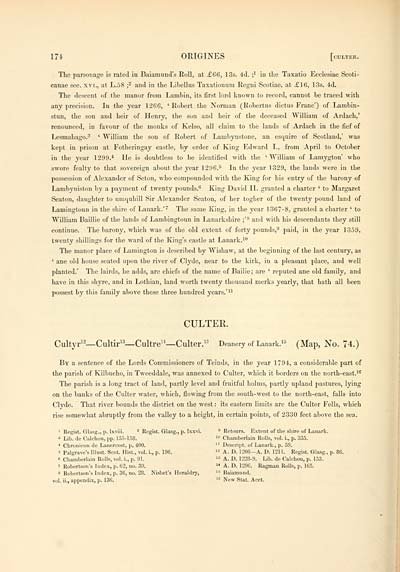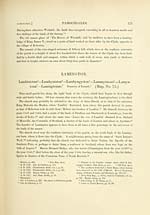Bannatyne Club > Origines parochiales Scotiae > Volume 1
(224) Page 174
Download files
Complete book:
Individual page:
Thumbnail gallery: Grid view | List view

174 OEIGINES [culter.
The parsonage is rated in Baiamunfl's Roll, at £66, 13s. 4il. ;' in the Taxatio Ecclesiae Scoti-
canae sec. xvi., at L.58 ;^ and in the Libellus Taxationum Regni Scotiae, at X16, 13s. 4d.
The descent of the manor from Lambin, its first lord known to record, cannot be traced with
any precision. In the year 1266, ' Robert the Norman (Robertus dictus Franc') of Lambin-
stun, the son and heir of Henry, the son and heir of the deceased William of Ardach,'
renounced, in favour of the monks of Kelso, all claim to the lands of Ardach in the fief of
Lesmahago.3 ' William the son of Robert of Lambynstone, an esquire of Scotland,' was
kept in prison at Fotheringay castle, by order of King Edward I., from April to October
in the year 1299.* He is doubtless to be identified with the ' William of Lamygton' who
swore fealty to that sovereign about the year 1296.^ In the year 1329, the lands were in the
possession of Alexander of Seton, who compounded with the King for bis entry of the barony of
Lambyniston by a payment of twenty pounds.'' King David II. granted a charter ' to Margaret
Seaton, daughter to umquhill Sir Alexander Seaton, of her togher of the twenty pound land of
Lamingtoun in the shire of Lanark.'' The same King, in the year 1367-8, granted a charter ' to
William Baillie of the lands of Lambingtoun in Lanarkshire ;'* and with his descendants they still
continue. The barony, which was of the old extent of forty pounds,^ paid, in the year 1359,
twenty shillings for the ward of the King's castle at Lanark. i"
The manor place of Lamington is described by Wishaw, at the beginning of the last century, as
' ane old house seated upon the river of Clyde, near to the kirk, in a pleasant place, and well
planted.' The lairds, he adds, are chiefs of the name of Bailie; are ' reputed ane old family, and
have in this shyre, and in Lothian, land worth twenty thousand merks yearly, that hath all been
possest by this family above these three hundred years.' ^^
CULTEK.
Cultyr''—Cultir"—Cultre"— Culter.'' Deanery of Lanark."^ (Map, No. 74.)
By a sentence of the Lords Commissioners of Teinds, in the year 1794, a considerable part of
the parish of Kilbucho, in Tweeddale, was annexed to Culter, which it borders on the north-east.'^
The parish is a long tract of land, partly level and fruitful holms, partly upland pastures, lying
on the banks of the Culter water, which, flowing from the south-west to the north-east, falls into
Clyde. That river bounds the district on the west : its eastern limits are the Culter Fells, which
rise somewhat abruptly from the valley to a height, in certain points, of 2330 feet above the sea.
' Regist. Glasg., p. Ixviii. ^ Regist. Glasg., p. Ixxvi. ' Retours. Extent of the shire of Lanark.
2 Lib. de Calchou, pp. 155-158. '" Chamberlain Rolls, vol. i., p. 335.
* Chronicon de Lanercost, p, 400. *' Descript. of Lanark., p. 59.
' Palgrave's Illust. Scot. Hist., vol. i., p. 196. '= A. D. r208— A. D. 1211. Regist. Glasg., p. 86.
« Chamberlain Rolls, vol. i., p. 91. " A. D. 1228-9. Lib. de Calchou, p. 153.
' Robertson's Inde.i, p. 62, no. .39. " A. D. 1296. Ragman Rolls, p. 165.
8 Robertson's Index, p. 36, no. 28. Nisbet's Heraldry, '* Baiamund.
vol. ii., appendix, p. 136. '* New Stat. Acct.
The parsonage is rated in Baiamunfl's Roll, at £66, 13s. 4il. ;' in the Taxatio Ecclesiae Scoti-
canae sec. xvi., at L.58 ;^ and in the Libellus Taxationum Regni Scotiae, at X16, 13s. 4d.
The descent of the manor from Lambin, its first lord known to record, cannot be traced with
any precision. In the year 1266, ' Robert the Norman (Robertus dictus Franc') of Lambin-
stun, the son and heir of Henry, the son and heir of the deceased William of Ardach,'
renounced, in favour of the monks of Kelso, all claim to the lands of Ardach in the fief of
Lesmahago.3 ' William the son of Robert of Lambynstone, an esquire of Scotland,' was
kept in prison at Fotheringay castle, by order of King Edward I., from April to October
in the year 1299.* He is doubtless to be identified with the ' William of Lamygton' who
swore fealty to that sovereign about the year 1296.^ In the year 1329, the lands were in the
possession of Alexander of Seton, who compounded with the King for bis entry of the barony of
Lambyniston by a payment of twenty pounds.'' King David II. granted a charter ' to Margaret
Seaton, daughter to umquhill Sir Alexander Seaton, of her togher of the twenty pound land of
Lamingtoun in the shire of Lanark.'' The same King, in the year 1367-8, granted a charter ' to
William Baillie of the lands of Lambingtoun in Lanarkshire ;'* and with his descendants they still
continue. The barony, which was of the old extent of forty pounds,^ paid, in the year 1359,
twenty shillings for the ward of the King's castle at Lanark. i"
The manor place of Lamington is described by Wishaw, at the beginning of the last century, as
' ane old house seated upon the river of Clyde, near to the kirk, in a pleasant place, and well
planted.' The lairds, he adds, are chiefs of the name of Bailie; are ' reputed ane old family, and
have in this shyre, and in Lothian, land worth twenty thousand merks yearly, that hath all been
possest by this family above these three hundred years.' ^^
CULTEK.
Cultyr''—Cultir"—Cultre"— Culter.'' Deanery of Lanark."^ (Map, No. 74.)
By a sentence of the Lords Commissioners of Teinds, in the year 1794, a considerable part of
the parish of Kilbucho, in Tweeddale, was annexed to Culter, which it borders on the north-east.'^
The parish is a long tract of land, partly level and fruitful holms, partly upland pastures, lying
on the banks of the Culter water, which, flowing from the south-west to the north-east, falls into
Clyde. That river bounds the district on the west : its eastern limits are the Culter Fells, which
rise somewhat abruptly from the valley to a height, in certain points, of 2330 feet above the sea.
' Regist. Glasg., p. Ixviii. ^ Regist. Glasg., p. Ixxvi. ' Retours. Extent of the shire of Lanark.
2 Lib. de Calchou, pp. 155-158. '" Chamberlain Rolls, vol. i., p. 335.
* Chronicon de Lanercost, p, 400. *' Descript. of Lanark., p. 59.
' Palgrave's Illust. Scot. Hist., vol. i., p. 196. '= A. D. r208— A. D. 1211. Regist. Glasg., p. 86.
« Chamberlain Rolls, vol. i., p. 91. " A. D. 1228-9. Lib. de Calchou, p. 153.
' Robertson's Inde.i, p. 62, no. .39. " A. D. 1296. Ragman Rolls, p. 165.
8 Robertson's Index, p. 36, no. 28. Nisbet's Heraldry, '* Baiamund.
vol. ii., appendix, p. 136. '* New Stat. Acct.
Set display mode to: Large image | Transcription
Images and transcriptions on this page, including medium image downloads, may be used under the Creative Commons Attribution 4.0 International Licence unless otherwise stated. ![]()
| Publications by Scottish clubs > Bannatyne Club > Origines parochiales Scotiae > Volume 1 > (224) Page 174 |
|---|
| Permanent URL | https://digital.nls.uk/81025672 |
|---|
| Description | Volume first. Diocese of Glasgow. |
|---|---|
| Shelfmark | SCS.BC.97 |
| Additional NLS resources: | |
| Attribution and copyright: |
|
| Description | Place of publication Edinburgh unless otherwise stated. No. 125 is relative to but not part of the club's series. |
|---|---|

